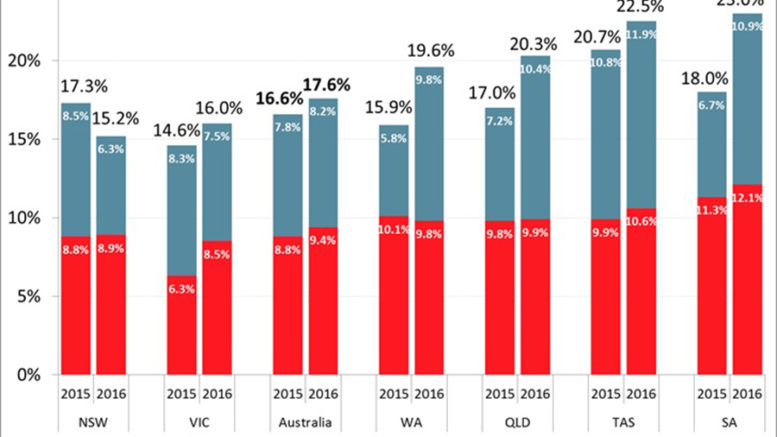Contributed by Joe Montero
Underemployment continues to rise and along with it Australia’s working poor. Australia has one of the highest rates in the OECD. There should be a national debate about this. Where are the headlines?
There are now more than 1.1 million Australians with jobs, but cannot find enough hours to maintain a decent standard of living. It should be a scandal. The government adds insult by hiding the numbers under the employed heading.
There is a reason why this is going on and it is that there is a deliberate policy to extend labour market flexibility. It has been around for a while and underemployment hides the extent of the impact. Once upon a time, employers had to mostly put people on full timers. Now they only have to keep a skeleton staff and put on others when busy.
The objective of increasing labour flexibility is to increase productivity. For three and a half decades, politicians , officials and employers organisations have promised that this would lead to economic growth and more jobs. We are still waiting. What there has been is a reduction in the wages share of national income.
In times of economic contraction, like we are in at present, the government can use underemployment to claim it is creating jobs and hide the real rate of unemployment. According to the Australian Bureau of Statistics (ABS), 5.8 percent were out of work in February. But, according to Roy Morgan (who tend to be conservative) and others, the real rate is at least double this, putting it at about the same level of those who find themselves underemployed. The discrepancy is partly accounted for by the fact that all is required is, to work one hour during the survey period, to be considered in full time employment. Those who are not receiving unemployment benefits, for whatever reason, are not counted as unemployed, even if they are looking for work.
Put the unemployed and underemployed together, and this makes up somewhere around 2.2 million Australians looking for work. It does not end here. About a third of the workforce is casualised. This is those Australians regularly moving in and out of employment, who not only don’t get a full regular wage, but are not entitled to such things as holiday pay, sick leave and increasingly, penalty rates. This indicates that somewhere between 4 and 5 million Australians are either working as a cheap source of labour, or are out of work.
The reason for the failure of the labour market flexibility process to bring about growth and jobs, is that it has not succeeded in cutting costs of production and hampered the capacity of the economy to absorb the goods and services that are going into the market.
For more than a decade, Australia has scored one of the world’s highest rates of productivity increase. Productivity refers to the quantity of output, over a given period of time. This can be measured as an hour. If two are produced instead of one and at half the cost in this time, productivity has doubled.
The sticking point is that the source of the rise in productivity has not been labour market flexibility and the cost of labour. It has been the result of the increase in the efficiency of capital, roughly at the rate of 2 to 1. Capital refers to the plant and equipment used. As output increases, labour is spread out more thinly and the per unit labour cost decreases. The cost of capital remains fixed for each unit and its total cost increases. increased productivity in these conditions leads towards a fall in the per unit profit
What labour market flexibility does do is provide an incentive for employers to cut corners to fill the gap in a falling rate of profit by rewarding less for work.
Unfortunately, the resulting redistribution of national income upward, means that workers as consumers have less disposable income and this makes the market get smaller. If it gets too bad, business is wound back and the real economy contracts. Major indicators like the low inflation and interest rates, sluggish sales at best, and of course, the failure to create jobs show that this is right.
According to the ABS 22.22 percent of young people between 15 and 24 are out of work. It’s a similar story for those over 50 and worst of all for women.
Statistics and the big picture have a drawback, in that they tend to hide human face of what is going on. People suffer.
Take the case of Kate Zizys, 46, has found herself underemployed her entire working life and earning less than $20,000 a year.
“I’m tertiary educated and have been in a casualised system my entire working life,” she says.
“I have had long periods of underemployment that border on unemployment. There’s not enough money or security in casual jobs.”
During the seven years, she worked at a university in Victoria, Ms Zizys was unable to get a permanent job. She ran a print-making studio in a fine arts school and tutored Indigenous students.
“I got breast cancer in 2013 and that was it for me,” Ms Zizys said. “You have no job and no leave entitlements.
“After my treatment, I managed to land a job in New Zealand for two years. That was the only full-time job I’ve had.”
Since April last year Kate Zizys says she has applied for 200 jobs and is still looking for full-time work.
Is this how Australia should be treating its own?


Be the first to comment on "Underemployment skyrockets to 1.1 million Australians"